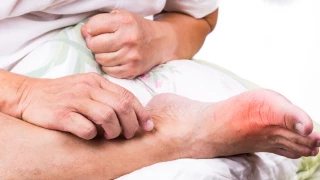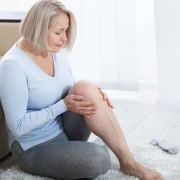
What is gout? What are the Symptoms and Treatment Methods?
- What is gout? What are the Symptoms and Treatment Methods?
- What Are Gout Symptoms?
- What are the Causes and Risk Factors of Gout?
- What Are the Complications of Gout?
- How Is Gout Diagnosed?
- How Is Gout Treated?
- How to Prevent Gout?
- Alternative Treatments (baslik)
The person may wake up in the middle of the night with the feeling that the big toe is on fire. It is so hot, swollen and tender that the weight of the pain becomes unbearable. These problems may indicate a severe attack of gout or gouty arthritis, a type of arthritis characterized by sudden attacks of severe pain, redness, and tenderness in the joints. Gout is a complex disease that can affect anyone, but men are more likely to develop gout than women, while women are particularly susceptible to gout after menopause. Fortunately, gout is treatable, and there are ways to reduce the risk of gout recurring.
What Are Gout Symptoms?
Typically, the symptoms of gout appear acutely and suddenly during the night, without prior warning. Its symptoms include:
- Severe joint pain: Gout generally and mainly affects the large joint in the big toe, but can also affect other joints in the palms of the foot, ankles, knees, hands, and pelvis. If gout is not treated, the pain may last for five to ten days and then disappear. The symptoms of gout subside and the discomfort gradually subsides over a period of one to two weeks, until the joint returns to its normal shape at the end of this period, the pain subsides, and the gout symptoms disappear completely.
- Inflammation and redness: The affected joint (or affected area) swells, turns red, and becomes very tender.
What are the Causes and Risk Factors of Gout?
Gout occurs when uric acid crystals build up around a joint, causing inflammation and severe pain (a gout attack). Uric acid crystals form in people with high levels of uric acid in the blood.
The body produces uric acid as part of the process of analyzing purine, a substance naturally found in the body and in certain types of food, such as viscera, anchovies, herring, mushrooms, and asparagus. Uric acid is generally soluble in the blood and passes into the urine through the kidneys. However, there are cases where the body can produce very large amounts of uric acid or the kidneys excrete very small amounts of uric acid. In these cases, uric acid accumulates in the form of sharp (jagged), needle-like crystals in the joint or in the surrounding tissues, resulting in pain, inflammation and swelling. Therefore, people with high levels (in concentrations) of uric acid in their body are more likely to develop gout.
- Many factors can cause an increase in the level of uric acid in the body, including:
- Lifestyle factors: Excessive consumption of alcoholic beverages
- Medical problems: hypertension, diabetes, hypercholesterolemia, hyperlipidemia and narrowing of the arteries (atherosclerosis)
- Some medications: Some medications containing thiazide – these are popular in the treatment of hypertension – and taking small doses of aspirin can raise uric acid. The same applies to taking 'anti-rejection drugs' taken by people who have had an organ transplant.
- Family history: Family history of gout
- Age and gender: Gout is more common in men than women. Men are more likely to develop gout at an earlier age than women – generally between the ages of 40 and 50, while women often experience gout symptoms and signs at 'menopause'.
What Are the Complications of Gout?
People with gout can develop complications more serious than the gout itself, and these can include:
- Recurrent gout
- Advanced gout
- Kidney stone
How Is Gout Diagnosed?
Tests that help diagnose gout include:
- Examination of the synovium in the joints
- Blood test
How Is Gout Treated?
In general, the treatment of gout is based on medications. These drugs are decided by the physician together with the patient, according to the patient's health status and preferences. Medications used to treat gout include:
- Non-Steroidal Anti-Inflammatory Drugs (NSAIDs / NAIDs)
- Colchicine
- Steroids
How to Prevent Gout?
There are some things you can do to reduce the risk of additional attacks, and these include:
Medicines:
Your doctor may recommend that people who experience gout attacks each year or who have fewer but more painful gout attacks take medications to reduce the risk of additional attacks. In general, after the gout attack comes and goes, preventive drug treatment is started.
Treatment options include:
- Drugs that inhibit uric acid production
- Drugs that improve uric acid secretion
Nutrition and gout:
Some dietary changes have been shown to reduce the risk of developing gout. However, it makes sense to eat foods that contain the least amount of purines possible. When trying to eat right for gout, it is recommended to follow the following:
- Reducing the intake of red meat and seafood (seafood)
- Avoid drinking alcoholic beverages
- Increase your intake of low-fat dairy products
- Increase your intake of complex carbohydrates, such as whole grain bread
Attention should be paid to the need to consume in amounts that will maintain a healthy weight. Losing weight can reduce the level of uric acid in the body. However, you should avoid fasting and rapid weight loss as these can cause a temporary increase in uric acid concentration.
Alternative Treatments (baslik)
If treatment does not produce the desired results, there is the possibility to try other complementary or alternative treatments for gout. Before you start adopting these methods, you should definitely consult your doctor. The physician can evaluate the preferences and risks and determine whether the alternative treatment risks hindering or affecting the effectiveness of the medications the patient is taking.
Some people have reservations about complementary and alternative therapies, but many traditional doctors today show great understanding and openness to the possibility of researching these treatments. Because only a small number of these methods have been tested in clinical trials, their true effectiveness in treating pain caused by gout is difficult to predict. In some cases, the risks these treatments may involve are unclear.
Complementary and alternative treatments for gout that are being investigated include:
Coffee: Researchers have found an association between drinking regular or decaffeinated coffee and low blood uric acid levels, but none of these studies have been able to explain how coffee affects uric acid in the body. The available evidence is insufficient to encourage non-coffee drinkers to drink, but it has the potential to open new horizons for researchers to develop treatments for gout.
Vitamin C: Food additives containing vitamin C can reduce the concentration of uric acid in the blood. However, there is currently no research examining the effectiveness of this vitamin as a gout treatment. It is wrong to think that if small amounts of vitamin C are beneficial to the body, large amounts of vitamin C will be more beneficial. An overdose of vitamin C can increase the concentration of uric acid in the body. Therefore, it is recommended to consult your doctor about the appropriate amount of vitamin C. It is useful to remember that it is also possible to increase the consumption of vitamin C by increasing the intake of vegetables, fruits and citrus fruits, especially oranges.
Cherries: Studies have shown an association between eating cherries and a reduced concentration of uric acid in the blood, but it is not clear whether cherries have any effect on gout symptoms. Adding cherries and other dark fruits such as blackberries (prickly berries), blueberries (cranberries) and purple grapes to the menu can be a surefire way to enrich and improve gout treatment, but it's best to consult a doctor about this.
There are other complementary and alternative therapies that can help cope with the pain caused by gout before it subsides or before the medications take effect. For example, some relaxation techniques such as deep breathing and meditation training – these can help to distract one's attention from the pain.




